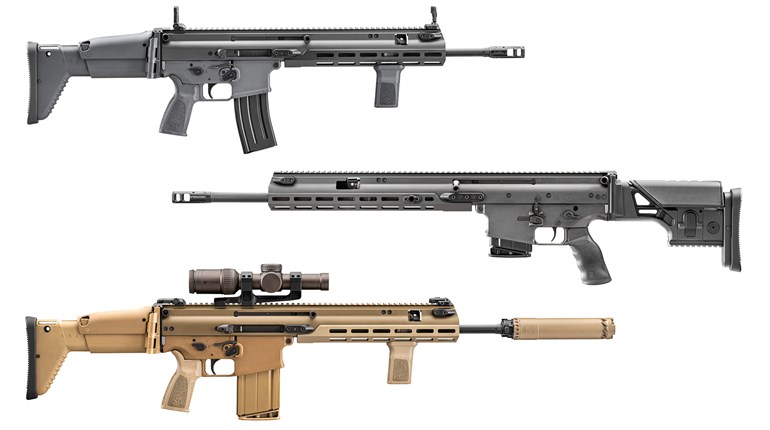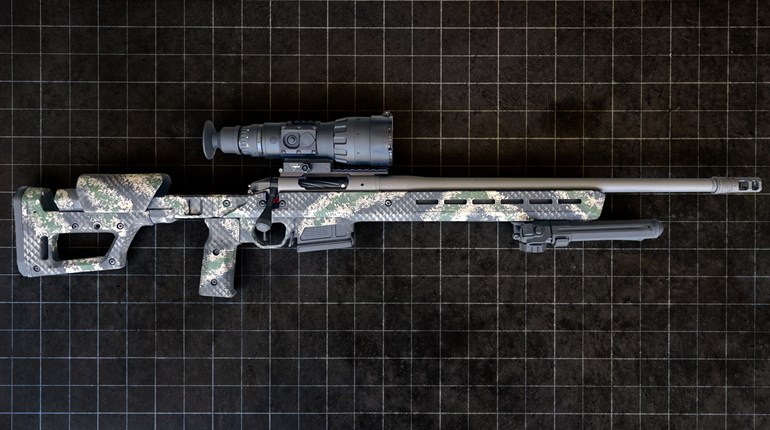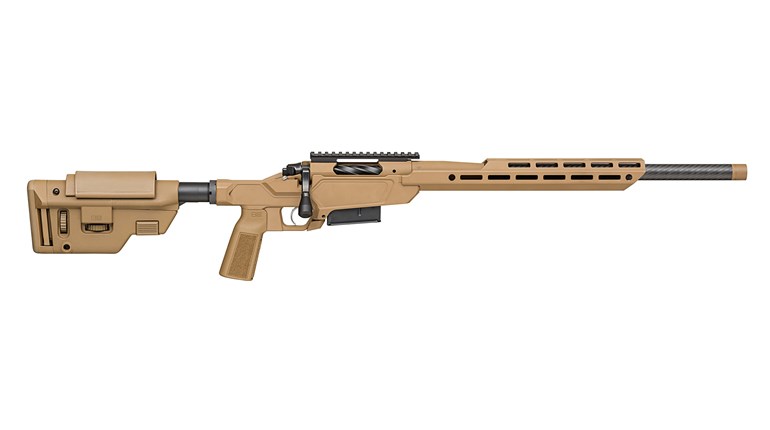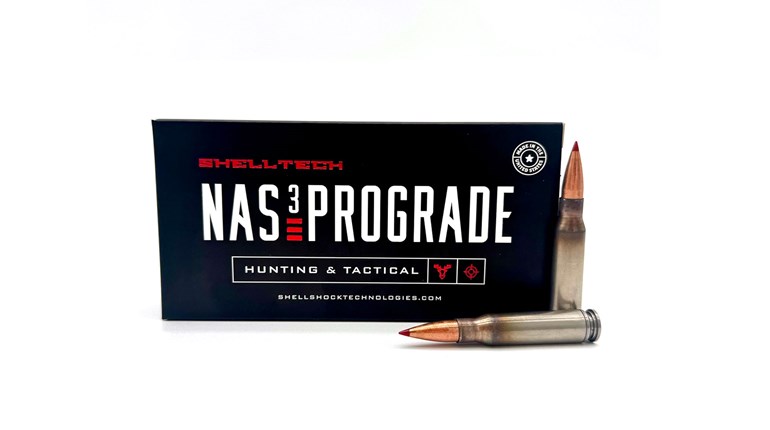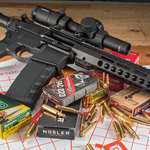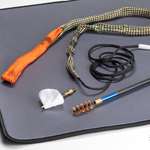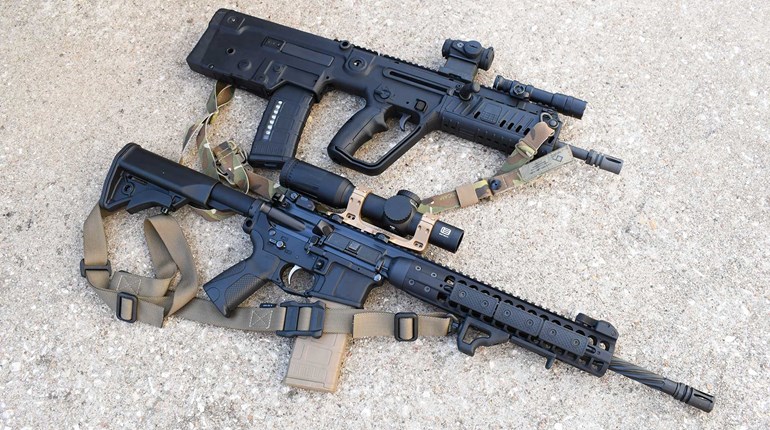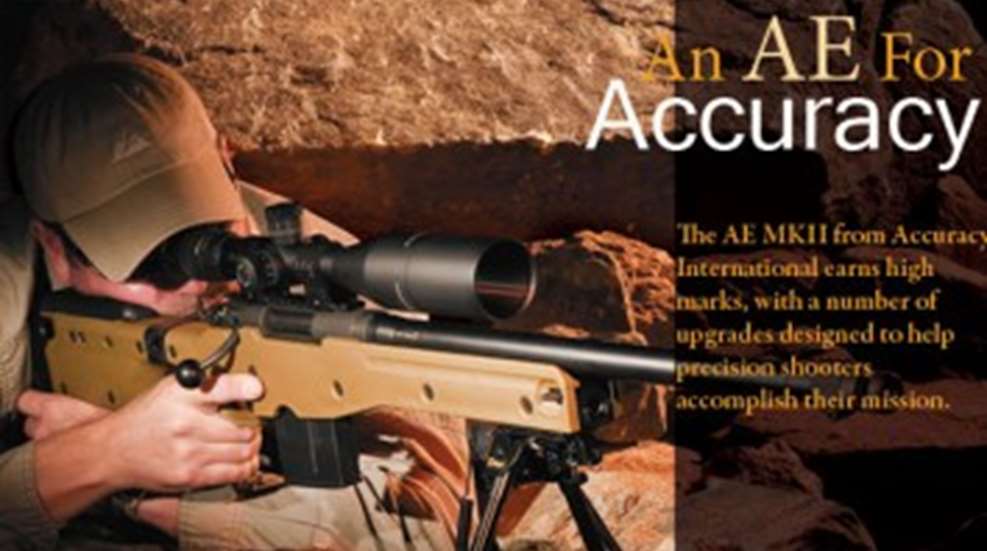
Accuracy International (AI) rifles have always been something of an enigma with mainstream shooters in the United States. These distinctive-looking bolt guns are known to tactical shooters around the world as accurate and extremely well-made precision rifles, but AI once had the less-flattering reputation of being slow or altogether absent in the customer-service department. Part of the problem was due to a patchwork of U.S.-based support centers, while a state of financial flux for the company in England added to the issue.
AI's rifles fall into one of two classes: the AW (Arctic Warfare) for the most demanding tactical and military needs, and the AE for law enforcement and "entry-level" shooters. The AW and AE categories each contain several models—the AE MKII updating the AE MKI with enhanced features borrowed from the AW line. The MKII designation means the 20-inch barrel (24 inches is also an option) can now be had in a threaded version with a tactical muzzle brake installed. The MKII also accepts AI Chassis System (AICS) five- and 10-round magazines, features an adjustable trigger group that's easy to remove and has a folding-stock option. While the military-friendly AW models are available in a left-handed configuration as a special-order option, the AE family unfortunately includes only right-handed versions.
My experience with AI rifles goes back to my Army sniper days. The rifles I was lucky enough to be issued were phenomenal tools in trained hands, rarely grouping outside 1⁄2 MOA with the right factory match ammunition. I learned very quickly that I owned every bad shot made with an AI in front of me.
Though it took some time for me to get used to the radically different ergonomics (as compared to the conventional stocks on which I was trained), I became an enduring fan once I adapted. If the popularity of the AICS is any indication, I'm in good company.
An admired retrofit for the Remington Model 700, the AICS allows the use of AI's furniture and full-length bedding block system. Although Model 700 rifles utilizing the AICS are seen increasingly on both ranges and fields of fire these days, their similarity to AI's bolt guns ends there.
Favorable FeaturesThe heart of any bolt gun is its action, which is where the AE begins its divergence from the AW. The receiver is lighter, rounded and sleek, as opposed to the larger, angular affair on AW models. A removable Picatinny rail attached to the receiver is standard issue on the MKII.
My loaner rifle had the tactical muzzle brake and side-folding stock, both good options in my opinion. In my active days, I conducted tactical military freefall parachute operations with a fixed-stock AW—27-inch barrel and all. A third leg that long is a recipe for bad night landings and lost zeroes. Suffice it to say, I was very happy when AI began offering its sturdy and well-designed side folder. Lockup is sound when extended, and the left-side retaining post does its job when folded. Though the pistol grip is left intact to allow a firing grip when folded, there's not much practicality in doing so except for extreme situations—such as a very close-range reactive shot—or other special circumstances.
The AE's fore-end is either capped at the front or fitted with a female receptacle for AI's heavy-duty, spigot-mounted bipod. This design hasn't curried much favor with American tactical shooters. Most spigot-mount bipod designs tend to be heavy, bulky and lack adequate tension to prevent the gun from flopping. Many are also noisy in transit, which is a big problem when carrying the rifle in places where clanking metal can compromise the shooter. Fortunately AI also includes a very strong, frame-anchored bipod-mounting stud on the bottom of the MKII's fore-end that accommodates Harris Bench Rest bipods and others with similar attachment systems.
Taking StockAs with other AI models, the MKII has an aluminum sub-frame (or "chassis" in proper English) that runs the length of the rifle in non-folding stocks and from fore-stock to pistol grip in folders. Unlike the AW, the AE's action is not permanently bonded to the chassis and can be removed with relative ease. Over the years I've found AI's V-block chassis system to be solid, durable and conducive to supporting the action as designed.
The chassis is cloaked in a removable pair of polymer stock sides (aka "skins") available in green, black or the ever-popular Flat Dark Earth. Removing two handfuls of screws along both sides is required to access the chassis and internal parts, which fortunately is not part of the normal maintenance regimen.
A pair of rigid, stamped sling mounts is present on either side, fore and aft, as well as a singular right-side mount near the folding stock's joint. The buttstock has a cheekpiece that can be adjusted via two hex screws, and a fixed-spacer system allows for length-of-pull adjustment. No monopod (a "butt spike" in AI-speak) is present on AE stocks, but the toe is well designed for gripping with the support hand to change elevation. The MKII has the familiar AI channel in the fore-stock's bottom, designed to accept an optional adjustable hand-stop.
A Feel That FitsIn terms of bullet-launching performance, the human interface element plays heavily into any rifle's design. AI takes this into account with all of its products, and though the concept would seem to be self-evident to any arms engineer, sometimes I'm left wondering (side-mounted magazines being one example). As a left-handed shooter in a right-handed world, I long ago learned to work a bolt's throw from the opposite side. My favorite prone technique is to cycle the action with my weak hand, but some lefties like to reach over the action and work it with their firing hand. Whether left- or right-handed, AI's short-throw bolt and large knob help increase efficiency—minimal movement and maximum speed—when cycling.
Another positive feature is the paddle-style magazine release. While these can be cumbersome on rifles used where speed under fire against close targets is vital, on bolt guns they preserve the rifle stock's integrity and provide ambidextrous accessibility. AI's rifles also allow the magazine to be pushed straight into and dropped from the magazine well, as opposed to the rocker-type magazine locking systems required by the paddle-style mag releases of the AK and G3. Straight-drop mags are always a benefit for reloading in the dark, when hurried or whenever your attention is devoted to concerns downrange. The feeding and function of the five- and 10-round magazines were flawless during my evaluation, totaling 230 rounds.
Ergonomically, the AI buttstock works well for me, and its adjustability allows for a good fit for most body types and shooting styles. Though I didn't have to raise the adjustable cheekpiece or change the buttstock spacers, it's good to have those options.
One feature I quickly discovered I don't like is the design of the safety lever. Though very secure, thanks to a firing-pin retracting and blocking mechanism, it's as non-ergonomic as I've seen on a modern bolt action. Like the AW series, the AE's safety is mounted on the right side, behind the bolt. Unlike the AW, rotating it forward to the fire position is not possible without coming completely out of a firing grip, regardless of your dominant hand. It's a long-throw lever, which makes it difficult to manipulate quickly.
Since all my firing was done from a prone-supported position, I got a good feel for the handling characteristics of the MKII's 20-inch barrel and tactical muzzle brake. I found the brake to be effective, though to be honest, a 131⁄2-pound rifle chambered in .308 Win. and sporting a 20-inch heavy barrel isn't known to be much of a shoulder kicker.
Precision-rifle circles occasionally see debate over whether threaded muzzles negatively affect accuracy. So far, in my shooting I've only seen problems with threaded muzzles on hammer-forged barrels, due to the potential for opening the muzzle after the barrel's outer diameter is turned down—prior to and during threading. AE MKII barrels all come from Lothar Walther and are button rifled, so it's not an issue. Since the muzzle brake is removable with normal tools, cleaning the crown is relatively easy so long as you verify zero afterwards.
The MKII's trigger is user-adjustable, with no requirement to disassemble the rifle or remove the trigger group. Two screws provide an adjustment range of 3.3 to 51⁄2 pounds. I found the two-stage trigger to be smooth through the first stage, crisp in the second and suitably repeatable for accurate shooting.
Trial by FireI spent several range sessions behind the driving end of the MKII. My goal was to first shake it out at 100 yards with a variety of loads, then group the best factory ammo and handloads at 300 and 600 yards. Not surprisingly, the MKII generally acquitted itself well at all ranges. Though it didn't scream "tack-driver" with any tested loads, I only used a small ammunition sample, limiting my chances to find the preferred load(s) for this particular gun.
The rifle still managed sub-MOA performance with the best factory ammo and handloads averaged together for all distances. The recipe for the best handload was far from a maximum load, providing only a modest starting velocity. Time and resources prevented me from a full workup, so I continued to use this same load throughout the test for consistency. The best factory load tested was Hornady's moly-coated 168-grain BTHP match round.
The barrel's 1:12-inch, RH twist rifling is unusually loose for a tactical rifle, and this is one area I think AI could easily improve. A twist in the 1:9-inch to 1:10-inch range would allow much heavier and longer tactical bullets, while a 1:11-inch twist would allow a wider range of projectiles. The loose twist drove me to employ lighter-weight projectiles in most testing.
Making the UpgradeThe recent changes within AI and AINA have provided better products and service to all customers. For American shooters, those changes have yielded a knowledgeable and responsive U.S.-based customer service team, faster order fulfillment for complete guns and parts, and a catalog of training courses available for armorers, gunsmiths and distributors at AINA's new Fredericksburg, VA, facility.
One thing that hasn't changed, however, is the quality delivered in the company's products. The AE MKII is the result of several years' work, and the improvements show in its functional upgrades over the MKI. Though it averages $2,000 less than AW rifles, it's still a bit harder on the wallet than many traditional, U.S.-built bolt guns. However, if approached from the standpoint of buying a high-quality rifle that delivers reliable, repeatable performance—one that will function in like-new condition for multiple generations—the price tag pales in comparison to the value spread out over the life of the gun. That alone makes the AI AE MKII worth serious consideration for precision rifle fans.












